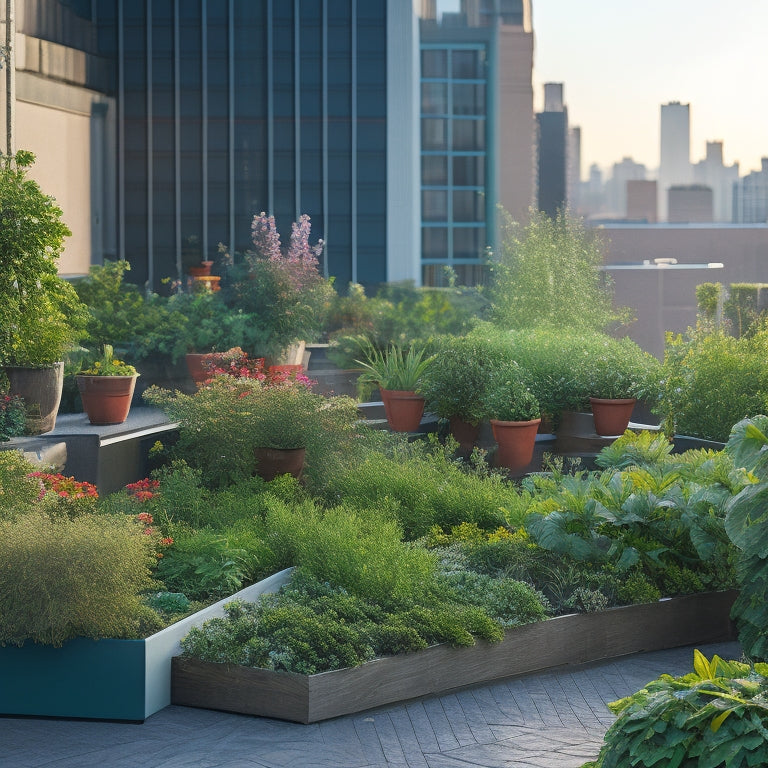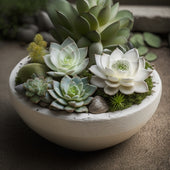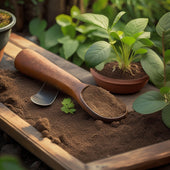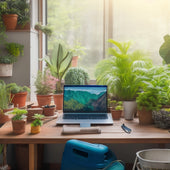
7 Best Irrigation Systems for Rooftop Fruit Gardens
Share
When it comes to rooftop fruit gardens, you need an efficient irrigation system that caters to your specific needs. Consider a drip irrigation system that delivers water directly to roots, reducing evaporation and runoff. Micro-sprinkler systems are ideal for vining plants like kiwis and grapes, providing gentle and uniform watering. You can also harness rainwater with rooftop harvesting systems or utilize soil moisture sensor technology for precise watering. Automatic timed watering systems, smart irrigation controllers, and rain barrel methods are also viable options. By exploring these seven systems, you'll find the perfect fit for your rooftop fruit garden, and uncover the secrets to maximizing yields and minimizing waste.
Key Takeaways
• Drip irrigation systems deliver water directly to roots, reducing evaporation and runoff, and boosting fruit yields.
• Micro-sprinkler systems provide uniform water distribution, ideal for vining plants like kiwis and grapes, promoting healthy growth.
• Rainwater harvesting systems reduce reliance on municipal water supplies, minimizing environmental footprint and lowering utility bills.
• Soil moisture sensor technology enhances irrigation efficiency, preventing overwatering or underwatering, and improving moisture retention and crop health.
• Smart irrigation controllers automate water distribution, allowing for customized scheduling based on weather forecasts and soil moisture, reducing risks of overwatering and underwatering.
Drip Irrigation for Fruit Trees
When designing an irrigation system for your rooftop fruit garden, consider using drip irrigation for fruit trees, as it delivers water directly to the roots, reducing evaporation and runoff. This targeted approach boosts drip efficiency, ensuring your trees receive the right amount of water exactly where they need it. By doing so, you'll promote fruit tree health and optimize growth.
Drip irrigation systems for fruit trees typically consist of a network of tubes and emitters that release water at a controlled rate. This slow and steady delivery allows the soil to absorb the water, minimizing waste and preventing overwatering. As a result, you'll see improved fruit yields, stronger tree structures, and reduced soil erosion.
To get the most out of your drip irrigation system, make sure to install it correctly. Place emitters near the tree's dripline, where the roots are most active, and adjust the flow rate according to your tree's specific needs.
With proper installation and maintenance, drip irrigation can become a game-changer for your rooftop fruit garden, providing you with a bountiful harvest while minimizing water waste.
Micro-Sprinkler Systems for Vines
You'll find micro-sprinkler systems particularly well-suited for rooftop fruit gardens featuring vining plants, such as kiwis or grapes. They provide a gentle, uniform watering pattern that encourages healthy growth and fruit production.
This is because micro-sprinklers deliver water directly to the soil, reducing evaporation and runoff. As a result, you'll see improved vine growth and increased fruit yields.
When designing your micro-sprinkler system, keep the following tips in mind:
-
Place micro-sprinklers 12-18 inches apart to guarantee thorough coverage of the soil.
-
Position micro-sprinklers near the base of the vine, directing the water towards the root zone.
-
Adjust the micro-sprinkler's flow rate to match the specific watering needs of your vine variety, taking into account factors like soil type and climate.
Soil Moisture Sensor Technology
When setting up your rooftop fruit garden's irrigation system, you'll want to guarantee you're getting accurate soil moisture readings to optimize water usage.
That's where soil moisture sensor technology comes in - with features like wireless convenience and real-time data insights, you'll be able to fine-tune your irrigation schedule like never before.
Accurate Moisture Readings Matter
Accurate moisture readings are vital in rooftop fruit gardens, as they enable you to identify the exact water requirements of your crops, thereby preventing overwatering or underwatering. When you have a clear understanding of your soil's moisture levels, you can enhance your irrigation system for maximum irrigation efficiency. This is especially important in rooftop fruit gardens, where water conservation is essential.
Here are some key benefits of accurate moisture readings:
-
Improved moisture retention: By knowing exactly how much water your soil can hold, you can reduce water waste and guarantee your crops receive the right amount of moisture.
-
Enhanced crop health: Accurate moisture readings help you identify potential issues before they become major problems, allowing you to take corrective action and maintain healthy, thriving crops.
-
Increased yield: With ideal watering, you can expect higher yields and better fruit quality, making your rooftop fruit garden a true success.
Wireless Sensor Convenience
One significant advancement in soil moisture sensor technology is the development of wireless sensors, which offer unparalleled convenience and ease of use in rooftop fruit gardens.
With wireless sensors, you can easily integrate them into your existing irrigation system, ensuring seamless sensor integration and eliminating the need for cumbersome wiring. This means you can focus on what matters most - growing healthy, thriving fruit.
Wireless connectivity also allows you to monitor your soil moisture levels remotely, giving you real-time updates on your garden's condition. This level of control enables you to make data-driven decisions, adjusting your irrigation schedule as needed to optimize water usage and reduce waste.
Plus, with wireless sensors, you can expand your monitoring capabilities without the hassle of running cables, making it easier to scale your rooftop fruit garden as it grows.
Real-Time Data Insights
By integrating wireless soil moisture sensors into your rooftop fruit garden's irrigation system, you'll gain instant access to real-time data insights, allowing you to pinpoint areas of ideal water saturation and make precise adjustments to your irrigation schedule.
This real-time analytics capability empowers you to take control of your garden's hydration, ensuring peak growth and minimizing waste.
With data-driven gardening, you'll be able to:
-
Optimize water distribution: Receive instant notifications when soil moisture levels drop, enabling you to adjust your irrigation schedule and prevent underwatering or overwatering.
-
Identify patterns and trends: Analyze historical data to identify patterns and trends in soil moisture levels, helping you refine your irrigation strategy and improve overall garden health.
-
Make data-driven decisions: Leverage real-time insights to respond to changing weather conditions, soil types, and plant water requirements, ensuring your garden receives exactly what it needs to thrive.
Rain Barrel Irrigation Methods
Collect rainwater in a barrel and connect it to a drip irrigation system to deliver water directly to the roots of your rooftop fruit garden plants, reducing evaporation and runoff.
This rain barrel irrigation method is a cost-effective and eco-friendly way to water your plants.
You'll need to verify the barrel is properly sized for your rooftop fruit garden, taking into account the square footage and water requirements of your plants.
A gravity-fed system is ideal, as it uses the natural flow of gravity to distribute water to your plants, eliminating the need for pumps or electricity.
To prevent overflow, make sure your barrel has an overflow prevention system in place, such as a valve or an overflow tube that directs excess water away from your rooftop.
By using a rain barrel irrigation system, you'll have better control over the water distribution, and your plants will thrive with the right amount of moisture.
With proper installation and maintenance, this system will provide your rooftop fruit garden with a consistent and efficient water supply.
Automatic Timed Watering Systems
You can upgrade your rooftop fruit garden's irrigation system with an automatic timed watering system, which uses a programmable timer to deliver water to your plants at set intervals, ensuring they receive the right amount of moisture exactly when they need it. This system provides you with complete control over the watering schedule, allowing you to customize it according to your plants' specific needs.
With an automatic timed watering system, you can:
-
Set specific watering times and frequencies to accommodate different plant types and weather conditions
-
Use smart drip irrigation to deliver water directly to the roots, reducing evaporation and runoff
-
Program your timer to water your plants during cooler parts of the day, reducing transpiration and minimizing water loss
Rooftop Rainwater Harvesting Systems
Harnessing rooftop rainwater for irrigation reduces your fruit garden's reliance on municipal water supplies, minimizing its environmental footprint and saving you money on utility bills.
By installing a rooftop rainwater harvesting system, you can collect and store rainwater for later use in your garden. The system typically consists of rooftop storage tanks, gutters, and downspouts that direct rainwater into the storage tanks.
You'll need to take into account the capacity of your rooftop storage tanks, considering factors like roof size, rainfall intensity, and irrigation demands. It's crucial to verify your storage tanks are properly sized to meet your garden's water requirements.
Additionally, you'll want to implement a rainwater filtration system to remove debris and contaminants from the collected water. This guarantees the water is safe for your plants and minimizes clogging in your irrigation system.
With a well-designed rooftop rainwater harvesting system, you'll have a reliable and sustainable source of water for your fruit garden, giving you greater control over your irrigation needs.
Smart Irrigation Controllers for Gardens
By integrating a smart irrigation controller into your rooftop fruit garden, it streamlines water distribution, ensuring your plants receive the right amount of water at the right time. This means you can say goodbye to overwatering and underwatering, and hello to healthy, thriving plants.
With smart watering, you'll enjoy:
-
Automated scheduling: Set a schedule that takes into account weather forecasts, soil moisture levels, and your plants' specific needs.
-
Real-time monitoring: Keep an eye on your garden's water usage and receive notifications when something's amiss.
-
Customizable settings: Tailor your irrigation system to accommodate different plant types, soil compositions, and microclimates.
Frequently Asked Questions
Can I Use a Single Irrigation System for Multiple Fruit Types?
'You're likely aware that 70% of fruit crops rely on irrigation. When considering a single system for multiple fruit types, you'll want to prioritize fruit compatibility to guarantee ideal water distribution and system efficiency, as certain fruits require more water than others.'
How Do I Prevent Clogging in Rooftop Irrigation Systems?
To prevent clogging in your rooftop irrigation system, you'll want to identify common clogging causes, such as debris and mineral buildup, and implement regular maintenance tips, like flushing filters and inspecting emitters, to guarantee peak performance.
Are Rooftop Irrigation Systems Suitable for Windy Areas?
"You're not thinking of installing an irrigation system in a hurricane zone, are you? Luckily, wind-resistant designs and durable irrigation system materials can withstand gusty conditions, so you can relax, knowing your rooftop oasis is secure."
Do Irrigation Systems Increase the Risk of Root Rot in Fruit Trees?
You control moisture levels to prevent root rot in fruit trees by ensuring your irrigation system doesn't overwater, as excess moisture compromises root health; instead, maintain ideal soil moisture to promote healthy root growth.
Can I Install an Irrigation System Myself, or Do I Need a Professional?
You're venturing into uncharted territory, but don't let uncertainty drown your DIY dreams! With careful planning and attention to installation tips, you can successfully tackle a DIY irrigation system, but be prepared for challenges that may require a professional's steady hand.
Related Posts
-

What Makes a Great Planter for Succulents
When selecting a great planter for succulents, you'll want to take into account a combination of factors to guarantee...
-

What Makes a Great Planter for Succulents
When selecting a great planter for succulents, you'll want to take into account a combination of factors to guarantee...
-

What Makes a Great Planter for Succulents
When selecting a great planter for succulents, you'll want to take into account a combination of factors to guarantee...
-

What Makes a Great Planter for Succulents
When selecting a great planter for succulents, you'll want to take into account a combination of factors to guarantee...
-

What Makes a Great Planter for Succulents
When selecting a great planter for succulents, you'll want to take into account a combination of factors to guarantee...
-

What Makes a Great Planter for Succulents
When selecting a great planter for succulents, you'll want to take into account a combination of factors to guarantee...
-

What Makes a Great Planter for Succulents
When selecting a great planter for succulents, you'll want to take into account a combination of factors to guarantee...
-

What Makes a Great Planter for Succulents
When selecting a great planter for succulents, you'll want to take into account a combination of factors to guarantee...
-

What Makes a Great Planter for Succulents
When selecting a great planter for succulents, you'll want to take into account a combination of factors to guarantee...
-

What Makes a Great Planter for Succulents
When selecting a great planter for succulents, you'll want to take into account a combination of factors to guarantee...
-

What Makes a Great Planter for Succulents
When selecting a great planter for succulents, you'll want to take into account a combination of factors to guarantee...
-

What Makes a Great Planter for Succulents
When selecting a great planter for succulents, you'll want to take into account a combination of factors to guarantee...
-

What Makes a Great Planter for Succulents
When selecting a great planter for succulents, you'll want to take into account a combination of factors to guarantee...
-

What Makes a Great Planter for Succulents
When selecting a great planter for succulents, you'll want to take into account a combination of factors to guarantee...
-

What Makes a Great Planter for Succulents
When selecting a great planter for succulents, you'll want to take into account a combination of factors to guarantee...
-

What Makes a Great Planter for Succulents
When selecting a great planter for succulents, you'll want to take into account a combination of factors to guarantee...
-

What Makes a Great Planter for Succulents
When selecting a great planter for succulents, you'll want to take into account a combination of factors to guarantee...
-

What Makes a Great Planter for Succulents
When selecting a great planter for succulents, you'll want to take into account a combination of factors to guarantee...
-

What Makes a Great Planter for Succulents
When selecting a great planter for succulents, you'll want to take into account a combination of factors to guarantee...
-

What Makes a Great Planter for Succulents
When selecting a great planter for succulents, you'll want to take into account a combination of factors to guarantee...
-

What Makes a Great Planter for Succulents
When selecting a great planter for succulents, you'll want to take into account a combination of factors to guarantee...
-

What Makes a Great Planter for Succulents
When selecting a great planter for succulents, you'll want to take into account a combination of factors to guarantee...
-

What Makes a Great Planter for Succulents
When selecting a great planter for succulents, you'll want to take into account a combination of factors to guarantee...
-

What Makes a Great Planter for Succulents
When selecting a great planter for succulents, you'll want to take into account a combination of factors to guarantee...
-

What Makes a Good Used Trowel for Planters
When searching for a good used trowel for planters, you'll want to prioritize corrosion-resistant materials like stai...
-

What Makes a Good Used Trowel for Planters
When searching for a good used trowel for planters, you'll want to prioritize corrosion-resistant materials like stai...
-

What Makes a Good Used Trowel for Planters
When searching for a good used trowel for planters, you'll want to prioritize corrosion-resistant materials like stai...
-

What Makes a Good Used Trowel for Planters
When searching for a good used trowel for planters, you'll want to prioritize corrosion-resistant materials like stai...
-

What Makes a Good Used Trowel for Planters
When searching for a good used trowel for planters, you'll want to prioritize corrosion-resistant materials like stai...
-

What Makes a Good Used Trowel for Planters
When searching for a good used trowel for planters, you'll want to prioritize corrosion-resistant materials like stai...
-

What Makes a Good Used Trowel for Planters
When searching for a good used trowel for planters, you'll want to prioritize corrosion-resistant materials like stai...
-

What Makes a Good Used Trowel for Planters
When searching for a good used trowel for planters, you'll want to prioritize corrosion-resistant materials like stai...
-

What Makes a Good Used Trowel for Planters
When searching for a good used trowel for planters, you'll want to prioritize corrosion-resistant materials like stai...
-

What Makes a Good Used Trowel for Planters
When searching for a good used trowel for planters, you'll want to prioritize corrosion-resistant materials like stai...
-

What Makes a Good Used Trowel for Planters
When searching for a good used trowel for planters, you'll want to prioritize corrosion-resistant materials like stai...
-

What Makes a Good Used Trowel for Planters
When searching for a good used trowel for planters, you'll want to prioritize corrosion-resistant materials like stai...
-

What Makes a Good Used Trowel for Planters
When searching for a good used trowel for planters, you'll want to prioritize corrosion-resistant materials like stai...
-

What Makes a Good Used Trowel for Planters
When searching for a good used trowel for planters, you'll want to prioritize corrosion-resistant materials like stai...
-

What Makes a Good Used Trowel for Planters
When searching for a good used trowel for planters, you'll want to prioritize corrosion-resistant materials like stai...
-

What Makes a Good Used Trowel for Planters
When searching for a good used trowel for planters, you'll want to prioritize corrosion-resistant materials like stai...
-

What Makes a Good Used Trowel for Planters
When searching for a good used trowel for planters, you'll want to prioritize corrosion-resistant materials like stai...
-

What Makes a Good Used Trowel for Planters
When searching for a good used trowel for planters, you'll want to prioritize corrosion-resistant materials like stai...
-

What Makes a Good Used Trowel for Planters
When searching for a good used trowel for planters, you'll want to prioritize corrosion-resistant materials like stai...
-

What Makes a Good Used Trowel for Planters
When searching for a good used trowel for planters, you'll want to prioritize corrosion-resistant materials like stai...
-

What Makes a Good Used Trowel for Planters
When searching for a good used trowel for planters, you'll want to prioritize corrosion-resistant materials like stai...
-

What Makes a Good Used Trowel for Planters
When searching for a good used trowel for planters, you'll want to prioritize corrosion-resistant materials like stai...
-

What Makes a Good Used Trowel for Planters
When searching for a good used trowel for planters, you'll want to prioritize corrosion-resistant materials like stai...
-

What Makes a Good Used Trowel for Planters
When searching for a good used trowel for planters, you'll want to prioritize corrosion-resistant materials like stai...
-

Must-Have Tools for Building Block Planters Online
When building block planters online, you'll need essential tools to guarantee a sturdy and visually appealing structu...
-

Must-Have Tools for Building Block Planters Online
When building block planters online, you'll need essential tools to guarantee a sturdy and visually appealing structu...
-

Must-Have Tools for Building Block Planters Online
When building block planters online, you'll need essential tools to guarantee a sturdy and visually appealing structu...
-

Must-Have Tools for Building Block Planters Online
When building block planters online, you'll need essential tools to guarantee a sturdy and visually appealing structu...
-

Must-Have Tools for Building Block Planters Online
When building block planters online, you'll need essential tools to guarantee a sturdy and visually appealing structu...
-

Must-Have Tools for Building Block Planters Online
When building block planters online, you'll need essential tools to guarantee a sturdy and visually appealing structu...
-

Must-Have Tools for Building Block Planters Online
When building block planters online, you'll need essential tools to guarantee a sturdy and visually appealing structu...
-

Must-Have Tools for Building Block Planters Online
When building block planters online, you'll need essential tools to guarantee a sturdy and visually appealing structu...
-

Must-Have Tools for Building Block Planters Online
When building block planters online, you'll need essential tools to guarantee a sturdy and visually appealing structu...
-

Must-Have Tools for Building Block Planters Online
When building block planters online, you'll need essential tools to guarantee a sturdy and visually appealing structu...
-

Must-Have Tools for Building Block Planters Online
When building block planters online, you'll need essential tools to guarantee a sturdy and visually appealing structu...
-

Must-Have Tools for Building Block Planters Online
When building block planters online, you'll need essential tools to guarantee a sturdy and visually appealing structu...
-

Must-Have Tools for Building Block Planters Online
When building block planters online, you'll need essential tools to guarantee a sturdy and visually appealing structu...
-

Must-Have Tools for Building Block Planters Online
When building block planters online, you'll need essential tools to guarantee a sturdy and visually appealing structu...
-

Must-Have Tools for Building Block Planters Online
When building block planters online, you'll need essential tools to guarantee a sturdy and visually appealing structu...
-

Must-Have Tools for Building Block Planters Online
When building block planters online, you'll need essential tools to guarantee a sturdy and visually appealing structu...
-

Must-Have Tools for Building Block Planters Online
When building block planters online, you'll need essential tools to guarantee a sturdy and visually appealing structu...
-

Must-Have Tools for Building Block Planters Online
When building block planters online, you'll need essential tools to guarantee a sturdy and visually appealing structu...
-

Must-Have Tools for Building Block Planters Online
When building block planters online, you'll need essential tools to guarantee a sturdy and visually appealing structu...
-

Must-Have Tools for Building Block Planters Online
When building block planters online, you'll need essential tools to guarantee a sturdy and visually appealing structu...
-

Must-Have Tools for Building Block Planters Online
When building block planters online, you'll need essential tools to guarantee a sturdy and visually appealing structu...
-

Must-Have Tools for Building Block Planters Online
When building block planters online, you'll need essential tools to guarantee a sturdy and visually appealing structu...
-

Must-Have Tools for Building Block Planters Online
When building block planters online, you'll need essential tools to guarantee a sturdy and visually appealing structu...


